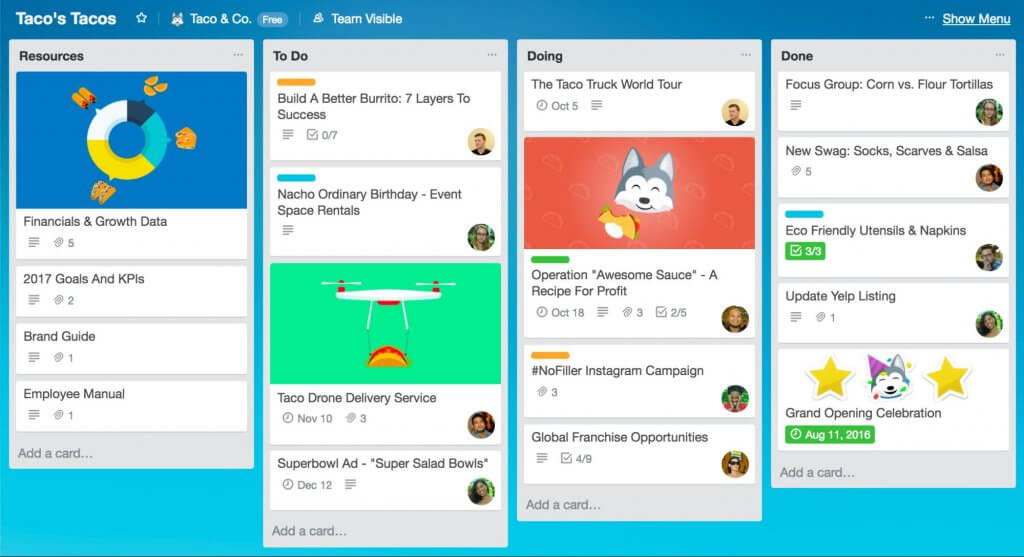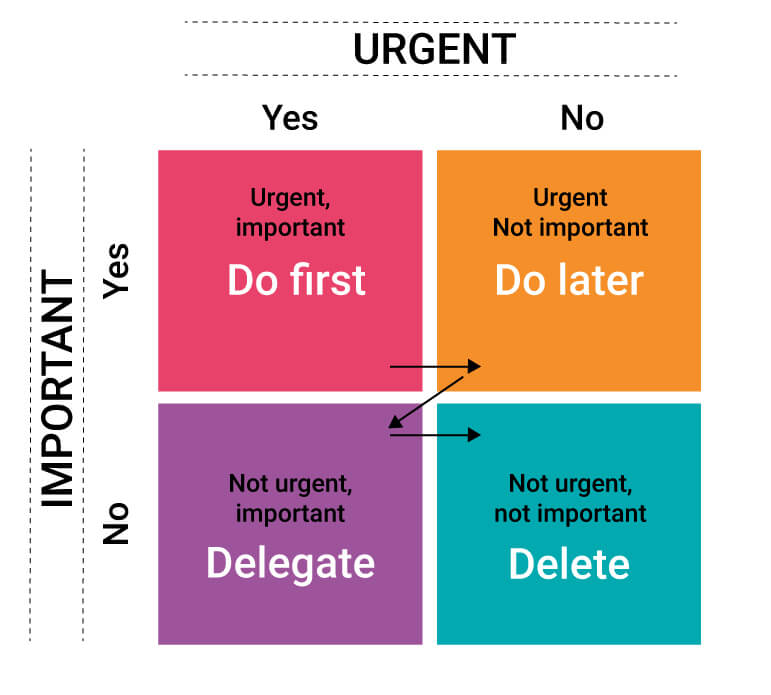Useful benefits of making a to-do list
The main purpose of making a to-do list is to lighten the mind, to comfort us in all that we have to accomplish. It is to write down tasks that we do not want to forget, but above all, to reduce stress.
This is obviously a good way to avoid forgetting deadlines while having an overview of the workload and/or project. Some may say that it takes time to plan its to-do list, but you will be more than rewarded for doing so. Your list is there to offer a structure that can be quickly browsed. You will therefore be more productive.
The main disadvantage of the to-do list
You can easily find yourself always modifying your to-do because life is not just a quiet river. The project you are working on may be postponed, your colleague is seriously ill and some of his tasks are delegated to you. Whatever the reason, it’s easy to get lost. You will need to be disciplined in managing your to-do list.
4 Practical tips for an effective to-do list
What exactly do your tasks consist of? Write everything down!
For the first few days or weeks, you could note everything you do in your day, in every single detail. By doing this exercise, you may discover some bad habits.
- Time spent on unnecessary activities: you watch YouTube videos on working time, you talk too much on the phone with a customer, you do presenteeism, etc.
- You are often the first to be willing to do the “small talk”.
- You have too much on your plate: look at the possibility of delegating tasks or even folders that you are not able to accomplish in a short period of time.
You will therefore understand how your days are going and be able to improve more adequately.
Estimate the time required to complete the project upwards
By estimating the time it takes to complete a task, your days will be more productive. Indicate the maximum amount of time you think this task will take you. It’s better to put more than not enough. You will feel less rushed by time and/or not late on your schedule.
Reminder and notification system
In addition to making your to-do list, it is important to make it on time. By using your calendar or a task management tool, you can use the reminder or notification system to be notified of deadlines on your various technological tools.

According to your circadian rhythm
The order of the tasks you are doing is important. Are you more focused in the morning? So start your day with the more challenging or creative tasks and end it with shorter, more repetitive tasks. It is important to keep up with your circadian rhythm!
8 types of classification of your to-do list
Make lists by priority
A list of tasks by priority is established according to the deadline but also based on the most urgent and important tasks. Of course, the priority is always to be reviewed as the tasks are carried out.
By doing these tasks first, you will be able to do the job well, do it on time, and be less stressed.
Your priority list can be color-coded or numbered. (1 being the most urgent for example)

A to-do list sorted by time period
To be done quickly (urgent): Maximum of 5 tasks and start with the most urgent one. This list must be reviewed daily.
As soon as possible (important, but not urgent): No more than 20, otherwise you prioritize and put these tasks in To Do Later. You pick into this list as soon as your urgent list is made.
To be done later (can wait): Put everything that needs to be done, project ideas, etc. To be reviewed once a week or more, it depends.
By task type
You could also group your tasks by similarity in order to maximize your day and reserve time blocks.
- all your calls at the same time
- administrative tasks
- tasks that require more concentration, such as writing
- planning tasks

The to-do list of the day
This list is prepared according to the priority of the moment and is made the day before or in the morning, according to your schedule of the day. This allows you to organize your time in an optimal way.
If you wish, you can indicate a time estimate for your tasks and provide real-time when the task is completed. With practice, you will be able to more accurately estimate tasks you can do in your day. Obviously, there will always be unscheduled meetings, tasks to be modified or added along the way. But you will be able to deal with it more effectively.
The to-do list for the day is constantly being modified and what you didn’t have time to do in your day should, in theory, be on your list for the next day.
The most unpleasant tasks first
We are usually in better shape in the morning, it might be interesting to start your workday with what you don’t like to do. This way, you will end the day on a more joyful note, with the tasks that you feel more comfortable doing and especially that you enjoy doing!
The to-do Kanban list
This way of proceeding, used among other things in scrums, organizes tasks into columns, in the form of a table such as Trello, in the following logic:
To do (several tasks) – Doing (1 task) – Done (several)

Eisenhower Matrix
First of all, write down all your tasks, even the banalest ones, on a sheet of paper. Then, you will have to prioritize them according to the following 4 conditions:
1. Urgent & important: the tasks you need to do immediately (deadlines, problems, crisis management)
2. Important, but not urgent (to be done later). Tasks that are not time-critical, but are very important to help you achieve your goals.
3. Urgent, but not important: the tasks you should delegate to someone else. These are urgent tasks that require your full attention but do not help you achieve your objectives.
4. Not urgent & not important: tasks you should delete.

Organize your tasks into projects
Write down the overall tasks of your project and then fragment them. You will feel that you are completing your project faster and it will be easier to follow it up than to go overall. You could have several lists that could represent folders with subfolders.
The ideal way to track project management tasks would be the Gantt chart.
How do you manage your tasks at work? The essential tools.
Your agenda
Would you prefer to write everything down in your agenda? I suggest that you only indicate the tasks that must be done at a specific date and/or time.
Example: Provide Excel training to my colleague Daniel.
Don’t make the mistake of indicating all your tasks directly in your calendar, you will spend more time managing your calendar than carrying them out because unexpected events happen more often than you think!
Your partner: A task manager
The task manager works in conjunction with your agenda. It synchronizes with your calendar.
While your agenda allows you to reserve a time slot for meetings, training, conferences, the task manager lists all your tasks. You can manage them from this tool for greater flexibility. It allows determining the priority, the status, to monitor the time of completion of the task or project, for increased efficiency.
A multitude of tools exists on the market (ntask, Flowlu) that use different layouts, from the simplest to the most complex, depending on your needs. In addition, the use of a task management tool offered in the web version (computer and smartphone) allows you to always have your list with you. Useful when you have an idea that you don’t want to forget.
If you have many meetings, you know that it can be difficult to follow all the tasks that have been assigned in meetings and especially when managing a work team. You should record them in your task manager following your meetings. But if you used a tool for this purpose, such as Beenote, managing tasks related to meetings becomes child’s play. Finally, you will be able to effectively monitor the progress of your team’s tasks.
In traditional mode
For the less technical, write on a sheet of paper, notepad (Google Keep) or an Excel sheet can always do the trick. The important thing is to be comfortable with what you choose and to find your way around quickly. We wouldn’t want to end up managing list lists of list lists….
5 Elements to remember to make an exceptional to-do list
- Note the main actions and not all the details.
- Indicate the tasks concretely with an action verb: Write the meeting agenda plan.
- Must be specific: Writing the agenda becomes Determining the topics on the agenda of the board meeting.
- A quick task that requires less time to complete. (less than 60 minutes). You could even use the Pomodoro Technique.
- Split up long tasks: gives the impression of completing the task faster:
- write the agenda becomes:
- identify topics
- determine the person in charge of the topics
- write the topics that belong to me and delegate the others
- attach documents
- write the invitation to the meeting
- send the meeting invitation
- write the agenda becomes:
The to-do list evolves over time, it is flexible. A to-do list is planned so that you can finally be efficient and productive at work. Don’t forget to include this planning on your agenda!
Last but not least, it is important to delete the elements from your to-do list, it allows you to visualize the progress of your day. Plus, it’s your personal little moment of gratification! You have worked so hard to plan this to-do list! Good continuity.









A perfect to-do list is effective, productive, creative, and contains tasks in the order of their importance. Using a task management app is also essential, and if you are looking for an alternative, take a look at https://blog.tmetric.com/10-fun-different-ways-to-keep-notes-and-to-do-lists/ – great tips and some apps!